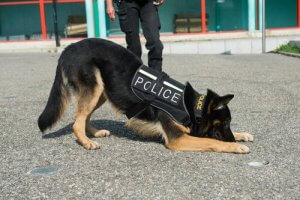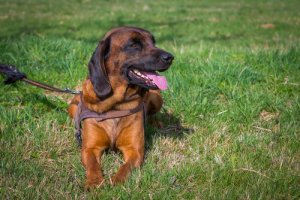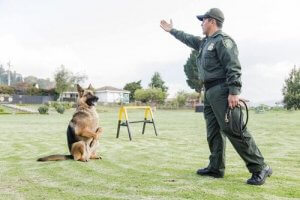What Are the Qualities of a Good Police Dog?


Written and verified by the lawyer Francisco María García
While many would undoubtedly be able to recognize a police dog, most people have no idea what it actually takes for these dogs to work in the police force. In this article, we’ll tell you all about the different qualities of a good police dog.
Police dogs are specially trained to aid in police investigations and help ensure the safety of the general public. They’re able to do all this thanks to their great intelligence, loyalty, keen instincts, and impressive olfactory abilities.
In the past, police services used several different breeds to perform a variety of different tasks. Today, however, the German Shepherd is the breed of choice.
Over the years, the role of the German Shepherd within the police force has gradually evolved. For centuries, these dogs were highly valued in Europe, especially among medieval nobles. Even before the First World War, the Armed Forces often counted German Shepherds among their ranks.
While the German Shepherd is undoubtedly the most popular, police services also use breeds such as Golden Retrievers and Rottweilers. These dogs are particularly useful for tasks such as:
- Bomb detection
- Firearm and drug detection
- Search and rescue after natural disasters
- Tracking suspects or missing persons
What does it take to become a police dog?
All police dogs must possess certain innate qualities in order to join the training program. Together, their natural attributes and specialist training set them apart from domestic dogs or ordinary pets.
While they lose none of their affectionate nature, police dogs must be disciplined, obedient and extremely alert.
The main characteristics that trainers look for in puppies is a natural interest and curiosity when it comes to play and exercise.

When it comes to police dogs, you’ll find that they are generally highly-intelligent, sociable and affectionate animals. Their great mental capacity must go hand-in-hand with physical endurance, strength and power. With their impressive stature, these dogs instantly command a certain respect.
A strong hunting instinct is fundamental for any police dog. Trainers use these natural instincts as the basis for teaching police dogs advanced tracking, rescue, and intervention techniques.
What are the main roles of a police dog?
Police dog training techniques are ever-evolving, and becoming more advanced every day. As such, dogs have been used for an increasingly wide variety of tasks over the years.
Today, you can classify these tasks into 4 broad categories:
1. Detection
Dogs that locate explosives, mines, tobacco, exotic animals, narcotics, and foreign currency, among other illegal items.
2. Intervention
Dogs who work to protect the public, rescue hostages, or track down criminals and offenders.
3. Rescue
There have been many cases in which police dogs have been the only ones able to save the lives of people trapped after avalanches, earthquakes, and other natural disasters, making good use of their olfactory and tracking abilities.
4. Scientific work
The police often use police dogs to locate cadavers, and to identify suspects and criminals.
The natural abilities of the German Shepherd, combined with their great physical strength, loyalty, and intelligence, have made them the breed of choice in all four of these categories.
Additional qualities of a police dog
Obedience is an essential quality for any good police dog. A dog that’s unable to obey its trainer’s commands will never be able to work in the police force. Police dogs need discipline and a calm temperament.
A police dog’s capacity for concentration must be so high, that their final test consists of passing a female dog in heat without reacting. This goes against the animal’s natural instincts, and is the ultimate proof of their extraordinary obedience.
The training and socialization of a police dog start from a very young age, when the dogs are still only puppies.
First, they learn the standard commands:
- Sit
- Stay
- Heel
- Fetch
The dogs must also be in peak physical health. Puppies with deformations, poor bone structure, or any other illnesses are unsuitable for the work of a police dog.
The activities and exercises used in police dog training require great strength and endurance. Poor physical condition can quickly get the dogs killed, compromise operations, and put the lives of both police officials and civilians at risk.

Conclusion
When it comes to training a police dog, all these traits are equally important. However, their most remarkable quality is undoubtedly their superb sense of smell. It’s these olfactory abilities that make police dogs so good at their job, and such an asset to police, and society as a whole.
It’s their great abilities and unwavering loyalty to their handlers that have made police dogs so successful. As such, the qualities of a police dog must be reflected in their human partners.
It’s impossible to train a good police dog without the leadership and guidance of a dedicated and responsible police officer.
Regardless of breed, color or age, every dog has the capacity to learn, and show affection. With discipline and advanced training techniques, the police have transformed many animals from domestic pet to professional police dog, making the very most of their natural abilities.
While many would undoubtedly be able to recognize a police dog, most people have no idea what it actually takes for these dogs to work in the police force. In this article, we’ll tell you all about the different qualities of a good police dog.
Police dogs are specially trained to aid in police investigations and help ensure the safety of the general public. They’re able to do all this thanks to their great intelligence, loyalty, keen instincts, and impressive olfactory abilities.
In the past, police services used several different breeds to perform a variety of different tasks. Today, however, the German Shepherd is the breed of choice.
Over the years, the role of the German Shepherd within the police force has gradually evolved. For centuries, these dogs were highly valued in Europe, especially among medieval nobles. Even before the First World War, the Armed Forces often counted German Shepherds among their ranks.
While the German Shepherd is undoubtedly the most popular, police services also use breeds such as Golden Retrievers and Rottweilers. These dogs are particularly useful for tasks such as:
- Bomb detection
- Firearm and drug detection
- Search and rescue after natural disasters
- Tracking suspects or missing persons
What does it take to become a police dog?
All police dogs must possess certain innate qualities in order to join the training program. Together, their natural attributes and specialist training set them apart from domestic dogs or ordinary pets.
While they lose none of their affectionate nature, police dogs must be disciplined, obedient and extremely alert.
The main characteristics that trainers look for in puppies is a natural interest and curiosity when it comes to play and exercise.

When it comes to police dogs, you’ll find that they are generally highly-intelligent, sociable and affectionate animals. Their great mental capacity must go hand-in-hand with physical endurance, strength and power. With their impressive stature, these dogs instantly command a certain respect.
A strong hunting instinct is fundamental for any police dog. Trainers use these natural instincts as the basis for teaching police dogs advanced tracking, rescue, and intervention techniques.
What are the main roles of a police dog?
Police dog training techniques are ever-evolving, and becoming more advanced every day. As such, dogs have been used for an increasingly wide variety of tasks over the years.
Today, you can classify these tasks into 4 broad categories:
1. Detection
Dogs that locate explosives, mines, tobacco, exotic animals, narcotics, and foreign currency, among other illegal items.
2. Intervention
Dogs who work to protect the public, rescue hostages, or track down criminals and offenders.
3. Rescue
There have been many cases in which police dogs have been the only ones able to save the lives of people trapped after avalanches, earthquakes, and other natural disasters, making good use of their olfactory and tracking abilities.
4. Scientific work
The police often use police dogs to locate cadavers, and to identify suspects and criminals.
The natural abilities of the German Shepherd, combined with their great physical strength, loyalty, and intelligence, have made them the breed of choice in all four of these categories.
Additional qualities of a police dog
Obedience is an essential quality for any good police dog. A dog that’s unable to obey its trainer’s commands will never be able to work in the police force. Police dogs need discipline and a calm temperament.
A police dog’s capacity for concentration must be so high, that their final test consists of passing a female dog in heat without reacting. This goes against the animal’s natural instincts, and is the ultimate proof of their extraordinary obedience.
The training and socialization of a police dog start from a very young age, when the dogs are still only puppies.
First, they learn the standard commands:
- Sit
- Stay
- Heel
- Fetch
The dogs must also be in peak physical health. Puppies with deformations, poor bone structure, or any other illnesses are unsuitable for the work of a police dog.
The activities and exercises used in police dog training require great strength and endurance. Poor physical condition can quickly get the dogs killed, compromise operations, and put the lives of both police officials and civilians at risk.

Conclusion
When it comes to training a police dog, all these traits are equally important. However, their most remarkable quality is undoubtedly their superb sense of smell. It’s these olfactory abilities that make police dogs so good at their job, and such an asset to police, and society as a whole.
It’s their great abilities and unwavering loyalty to their handlers that have made police dogs so successful. As such, the qualities of a police dog must be reflected in their human partners.
It’s impossible to train a good police dog without the leadership and guidance of a dedicated and responsible police officer.
Regardless of breed, color or age, every dog has the capacity to learn, and show affection. With discipline and advanced training techniques, the police have transformed many animals from domestic pet to professional police dog, making the very most of their natural abilities.
This text is provided for informational purposes only and does not replace consultation with a professional. If in doubt, consult your specialist.








